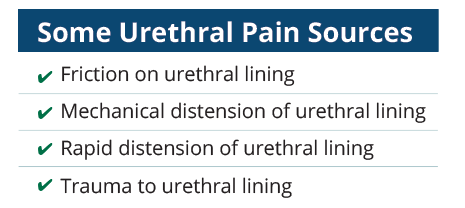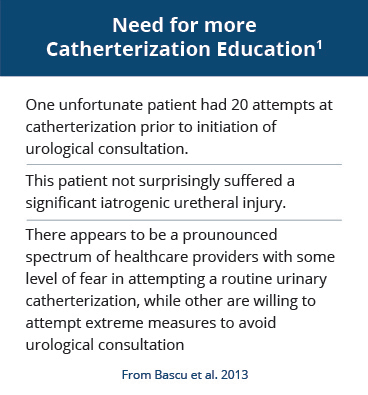Catheterization – Difficulties and Injury Prevention
Urethral Pain & Catheterization
It is well known that inserting a catheter or surgical instrument into a urethra produces pain and likely induces the fear of pain or injury in any patient having it done for the first time.
- Besides pain caused by friction of a catheter, mechanical stretching of the urethra by catheterization or other urological procedures is painful1
- Catherization was ranked by patients as the 3rd most painful invasive procedure in hospitals2
- Studies report 15% – 25% of patients staying in hospital and 7.5% – 10% of patients in long term care are catheterized2
 Since pain can be caused by stretching of distending the urethra, a study also looked at the impact of the delivery rate at which lubricating gel was instilled into the urethra and the perception of pain as the urethra was distended.1
Since pain can be caused by stretching of distending the urethra, a study also looked at the impact of the delivery rate at which lubricating gel was instilled into the urethra and the perception of pain as the urethra was distended.1
- Researchers found a slower 10 second instillation rate of lubricating gel versus a more rapid 2 second instillation rate of gel produced significantly less pain.
- From this data it appears the slower instillation rate of gel produced a slower rate of urethral distension allowing more time to accommodate and thus produced less pain.
It is highly probable that tissue trauma and damage will occur during catheterization since the urethra has a thin lining is rich in blood vessels, connective tissue and nerve tissues, and passage may be compounded by various other physiologic factors, such a BPH or strictures.2
This demonstrates the importance of Instilling a lubricating gel like Cathejell into the urethra and doing so slowly, since it gradually distends the urethral folds, reducing pain, while opening and filling the urethra with gel eases insertion of the catheter, and reduces the risk of injury. Cathejell’s unique accordion style syringe was designed specifically to allow a controlled slow, low pressure instillation rate of gel into the urethra resulting in a more gradual distension of the urethra and lowering the risk of pain.
Clearly every effort should be taken to put patients at ease regarding catherization and reduce the amount of pain experienced.

Slower gel instillation = significantly less pain
Cathejell‘s accordion syringe is designed for slow gel instillation
References
- Tzortzis et al, Intraurethral Lubricants-a Critical Literature Review and Recommendations, J of Endourology, vol 23, Number 5, May 2009 p821-82
- Aygin D, Usta E., The effect of lubricants used in indwelling bladder catheterization through urethra on procedure-related pain: a literature review, Int J Clin Exp Med 2017

Catheter Injuries – Can We Prevent More of Them?
While to most healthcare practitioners catheterization is a simple low risk procedure, instilling a catheter is subject to several variables that increase the risk of injury.
As a result, some attempts at catheterization are done by individuals who know how to do a catheterization but have limited experience and so do not realize that perhaps they should not be the ones doing it.
The consequences of incorrect catheterization can result in injuries that can be serious and costly.
- 2018 multicenter US study of complications with urethral catheters found:1
- 57% of patients had 1 complication with their indwelling catheters, and this is likely under reported
- Non-infectious complications were 5x more reported than infectious complications
- In 2016, a 6-month study found an incidence rate of traumatic catheter insertion of 6.7/1000 catheters resulting in iatrogenic injuries for 37 patients, an additional hospital stay of 9+ days, with increased in-hospital costs of $371,790 US, plus additional out of hospital costs3
- Injury type
- Most common, urethral trauma, false passage during insertion, inflation of balloon in the urethra
- More serious ones with gross haematuria requiring transfusion, rectal perforation, UTI/uro sepsis, formation of urethral strictures, paraphimosis1,2
In terms of preventing catheter injuries:
- The authors noted most iatrogenic injuries can be avoided and thus have medicolegal implications
- Improved training in catheterization techniques and equipment could greatly reduce the risk
References
- Saint, Sanjay et al, A Multicenter Study of Patient-Reported complications with Indwelling catheters, JAMA Internal Medicine, 2018; 178(8): 1078-1085
- Thomas, Arun et al, Avoidable iatrogenic complications of urethral catheterization and inadequate intern training in a tertiary-care teaching hospital, BJU International 2009, 104, 1109-1112
- Davis, NF et al, Incidence, Cost, Complications and Clinical Outcomes of Iatrogenic Urethral Catheterization Injuries: A Prospective Multi-Institutional Study, The Journal of Urology, vol 196. 1473-1477 Nov 2016
Difficult Urinary Catheterization
A common complaint of urological departments is the number of calls after hours from other departments who either have a patient that they can’t catheterize, or there is no staff available to catheterize them or no staff who feels competent to do the procedure.1 Sometimes this means an after hours consultation by a urologist to catheterize a patient in another department
One of the most common reasons for hospital urological consults is Difficult Urinary Catheter (DUC) insertion 1
- 2013 Canadian study1 by Dr. Chasta Bacsu et al at the University of Alberta and the Royal Alexander hospital had 81 difficult urological catheter consults over 4 months where:
- 37% experienced AE, including urethral trauma, urosepsis, bladder perforation, paraphimosis, and hydrouterus
- 32% had iatrogenic urethral trauma as a result of catheterization (false passage)
- Mean number of catheterization attempts was 2.7 +7 (0-20),
- On review 40% of the catheterizations were classified as easy and only 60% were DUC
- 43% of DUC consults were avoidable saving injury and costs
- 53% occurred between 5 pm and 6:30 am, past normal work hours (delay in time until consult increases risk in a DUC)



Several studies have identified the need for ongoing urethral catheter insertion education programs to reduce iatrogenic urethral catheterization injury1,2,3,4
Studies reported one of the more common tips to minimize urethral trauma and make catheter insertion easier is to ensure sufficient lidocaine gel is used, at least 10-20 mL for a male. Urologists often add more gel before they attempt a repeated insertion.2,3,4,5
References
- Bacsu, Chasta et al, A prospective analysis of consultation for difficult urinary catheter insertion at tertiary care centres in Northern Alberta, CUAJ Sept-Oct 2013 Vol 7, issues 9-10
- Thomas, Arun et al, Avoidable iatrogenic complications of urethral catheterization and inadequate intern training in a tertiary-care teaching hospital, BJU International 2009, 104, 1109-1112
- Davis, NF et al, Incidence, Cost, Complications and Clinical Outcomes of Iatrogenic Urethral Catheterization Injuries: A Prospective Multi-Institutional Study, The Journal of Urology, , vol 196. 1473-1477 Nov 2016
- Paul Willette and Scott Coffield, Current Trends in the Management of Difficult Urinary Catheterizations, Western J of Emergency Medicine, vol XIII, no 6 Dec 2012 p 472-478
- Carlos Villanueva, George Hemstreet III, Difficult Male Catheterization: A Review of Different Approaches, Int Braz J Urol, 2008; 34; 401-412
Why Not Set Up A Catheterization Training Program in Your hospital? Biosyent Can Help.
BioSyent recognizes the value of catheterization education and has undertaken initiatives to support hospitals in their desire to improve their staff’s knowledge and understanding of catheterization.
- BioSyent offer some financial support to help in preparing and running training events or to fund speakers to provide the training.
- BioSyent also has some presentations that staff can adapt to help them with setting up their own training presentation.
- Speakers from the Urology Nurses of Canada who can present on a variety of catheterization related topics and provide firsthand information on managing difficult urinary catheterizations in a variety of patient scenarios.
For more information on how BioSyent can help you set up a catheterization training event in your hospital, simply fill in the contact information on the contact page or reach out to your BioSyent Specialist Representative if you have their contact information. We will get back to you quickly to help with your catheterization educational program.

 2476 Argentia Road, Suite 402
2476 Argentia Road, Suite 402 1.888.439.0013
1.888.439.0013 905.206.1413
905.206.1413 cathejell@biosyent.com
cathejell@biosyent.com